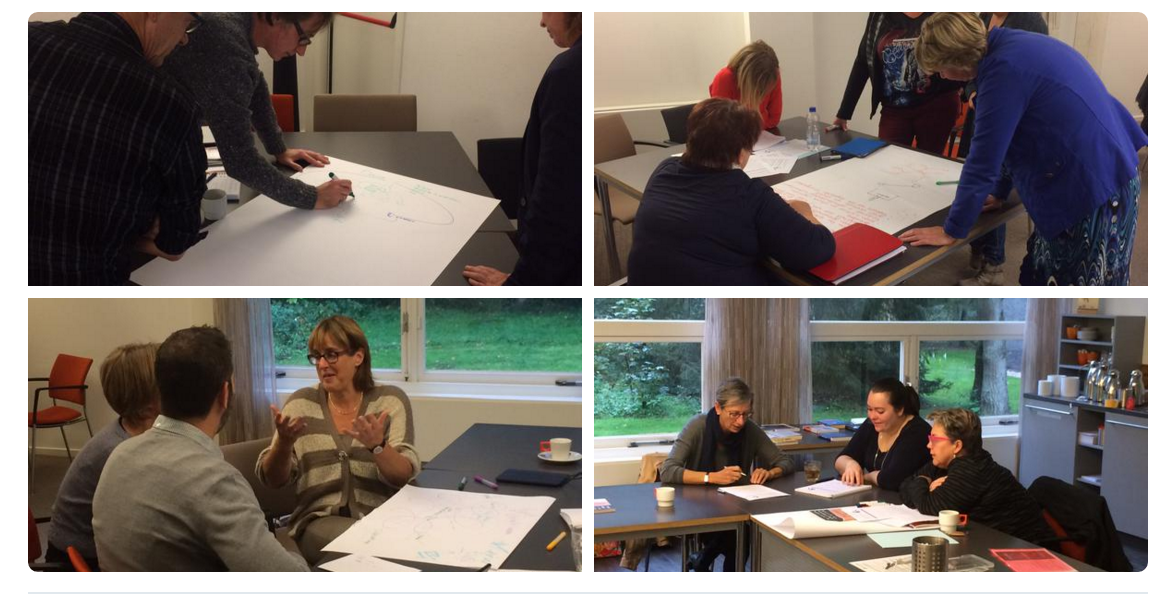I read a paper called
Perspectives on learning and technology: A review of theoretical perspectives"This paper provides a review of literature pertaining to theoretical references on educational practice and technology from perspectives of learning theories of the 20th and 21st centuries."
A learning theory (or theories) helps understand how people learn, thereby assisting educators, trainers and facilitators reflect on their educational practices. The three major prominent learning theories are known as behaviourist, cognitivist and constructivist, though Siemens later developed the
connectivism theory as a learning theory for the digital age. The
graph displays more theories and some of the major terms used.
The paper caught my interest because I am a fan of social constructivist theories of learning (think: learning by conversation) and always amazed at how differently people can think about what learning is and what it needs. For me it is obvious that Twitter can be an important learning instrument but if see you learning as acquiring new knowledge it is less obvious.
'Twitter is not about learning. How can you learn from 140 characters?! I blogged about the difference before in:
twittering= learning? I know my preferences but more and more I start the see the learning theories as all saying something about realities, in other words as pieces of the same puzzle. Depending on the situation a certain theory (and practice) may fit better. Interestingly the practices of people with different ideas may be pretty close...
I think the implicit learning theories people use determine how enthousiastic you are about new technologies and shape which application you see. The three theories outlined in the paper with their use of technology are:
1. Behaviourist theory
The main purpose of the behaviourist learning pedagogy is to accomplish the correct behaviour which focuses on achievable learning objectives. Behaviourist focus on learning objectives in 'to do' in the sense of describing observable behaviour. For instance, "
when dealing with a complex problem X will contact relevant colleagues for input." The knowledge skills and attitude distinction is also used within this approach. In the context of online learning based on the behaviourist theory the focus is on delivering learning content with clear intended
behavioural objectives, and drill and practice and ’electronic page turning‘. Somehow the traditional e-learning modules.
2. Cognitivism theory
Cognitivist views of learning recognize the importance of the human mind in making sense of the material with which it is presented (Harasim, 2012; Schunk, 2012). Cognitivists sought to understand what was inside the black box of the human mind and tried to emulate it computationally. Cognitivists developed educational technologies such as intelligent tutoring systems (ITS) and artificial intelligent (AI). "In
addition, online learning based on a cognitivist approach is focused on a learner’s working
memory and sensory system. This is done through utilising different multimedia modality (e.g. audio, visuals, animations, or video), the proper location of information on screen, screen attributes (e.g. colour, size of text, or graphics), the pacing of the information, and information chunks to avoid information overload." The cognitivism use of technology is hence very instructionally oriented, focussing on proper media to convey information. The recent focus on 'brainscience' may help to support the cognitivism practices.
3. Constructivist theory and social-constructism theories.
Constructivist learning theory views learning as a process by which a student constructs knowledge thorough interacting with more knowledgeable others; "learning starts by conversations". it is an umbrella term representing a range of perspectives on learning. Educational practices adopted the constructivist approach including situated and active learning, learning by doing, problem-based learning, inquiry-based learning, cooperative learning, collaborative learning, personalised learning, the learning community, active participatory learning, activity and dialogical processes, anchored instruction, cognitive apprenticeship, discovery learning, and scaffolded learning. The constructivist learning technologies are often associated with learning environments and Learning Management Systems such as BlackBoard, WebCT or Moodle with characteristics including the following:
- providing multiple representations of reality to prevent oversimplification and represent the natural complexity of the real world;
- emphasize knowledge construction and co-creatiom instead of knowledge reproduction
- provide learning environments such as real-world settings or case-based learning instead of a predetermined sequence of instruction
- foster reflection on learning experiences;
- online learning based on a constructivist approach including learning should be an active process; learners should construct their own knowledge
I was a bit disappointed with the explanation in the paper.. I had expected a deeper explanation. I would like to add social learning (probably part of the social-constructivism group) because this theory is really charmed by social networks rather than learning management systems. See Jane Hart's
use your Enterprise Social Network for workplace learning.
What I notice is that in technology/ tools, there is a code in the technology (like DNA!) and the code is determined by the people who developed the technology. Hence it makes it hard for people with a different view to use the technology for a different purpose. This code in the technology is very implicit. For instance, we use Ning, a social network for our learning trajectories whereas we could use a learning management system (LMS). However, most of the LMS we tested are way less focussed on interaction and learners in the driving seat than we like. An example: when I work with Moodle the technology invites me to prepare the course with all sections in advance. In Ning, the technology invites me to start on the fly with new discussions. This stimulates a more flexible role for the facilitator.
Lesson? It is important to know your own convictions when choosing and using technology.. and try to find 'the code in the technology' you want to buy or try.



 I often hear: "technology is just a tool and should be the starting point, let's start with the goal and the technology will follow". "The tech does not matter if we achieve our goal." In this blog post, I argue that technology is much more than a means. Social technology is a driving force behind social learning. And even within organizations and networks the choice of (social) technology is extremely important and can be a factor determining success or failure.
I often hear: "technology is just a tool and should be the starting point, let's start with the goal and the technology will follow". "The tech does not matter if we achieve our goal." In this blog post, I argue that technology is much more than a means. Social technology is a driving force behind social learning. And even within organizations and networks the choice of (social) technology is extremely important and can be a factor determining success or failure. The pill is an example of a revolutionary technology that has caused changed behavior. Evert Chain shows the pill is an example of the right technology at the right place at the right time. When looking for 500 volunteers to test this contraceptive there were 5000 registrations. 10 years after the introduction of the pill in the Netherlands in 1962 it was already used by two thirds of women. Twenty years later, the use of the pill has become the norm A research in 1988 discovered a 16-year-old girl thought it was impossible to have sex without birth control pills, she did not know the pill prevents pregnancy. The major mindset change introduced by the pill is that sexuality was disconnected from pregnancies. Before the pill, there were already other contraceptives like diaphragms and condoms. However, the pill has become a huge success. One of the reasons is that taking the pill is independent of the sexual activity, and thus was respectable. And of course, the use lies in the hands of women. Finally, it is a more reliable method, so doctors also accepted it.
The pill is an example of a revolutionary technology that has caused changed behavior. Evert Chain shows the pill is an example of the right technology at the right place at the right time. When looking for 500 volunteers to test this contraceptive there were 5000 registrations. 10 years after the introduction of the pill in the Netherlands in 1962 it was already used by two thirds of women. Twenty years later, the use of the pill has become the norm A research in 1988 discovered a 16-year-old girl thought it was impossible to have sex without birth control pills, she did not know the pill prevents pregnancy. The major mindset change introduced by the pill is that sexuality was disconnected from pregnancies. Before the pill, there were already other contraceptives like diaphragms and condoms. However, the pill has become a huge success. One of the reasons is that taking the pill is independent of the sexual activity, and thus was respectable. And of course, the use lies in the hands of women. Finally, it is a more reliable method, so doctors also accepted it. Like the pill social media is a technology at the right time in the right place. It fits into a trend of individualization and self-expression. Combined with the widespread use of smartphones and tablets it enables a continuous flow of communication with your networks, sports clubs and friends. It is an important technology-driven change in society. The influence of social media on society is huge because a new way of social learning is enabled by social media, in organization, between organizations and in spontaneous networks. Isaac Newton wrote: "If I can see far, it is because I am standing on the shoulders of giants." By publicly sharing work and ideas, considering the rate at which messages are spread through social media it is possible to stand on the shoulders of a lot of fellow professionals. Social media is a driving force that increasingly influences our daily thinking and actions. That is a huge innovation in learning driven by the technology of social media.
Like the pill social media is a technology at the right time in the right place. It fits into a trend of individualization and self-expression. Combined with the widespread use of smartphones and tablets it enables a continuous flow of communication with your networks, sports clubs and friends. It is an important technology-driven change in society. The influence of social media on society is huge because a new way of social learning is enabled by social media, in organization, between organizations and in spontaneous networks. Isaac Newton wrote: "If I can see far, it is because I am standing on the shoulders of giants." By publicly sharing work and ideas, considering the rate at which messages are spread through social media it is possible to stand on the shoulders of a lot of fellow professionals. Social media is a driving force that increasingly influences our daily thinking and actions. That is a huge innovation in learning driven by the technology of social media.











